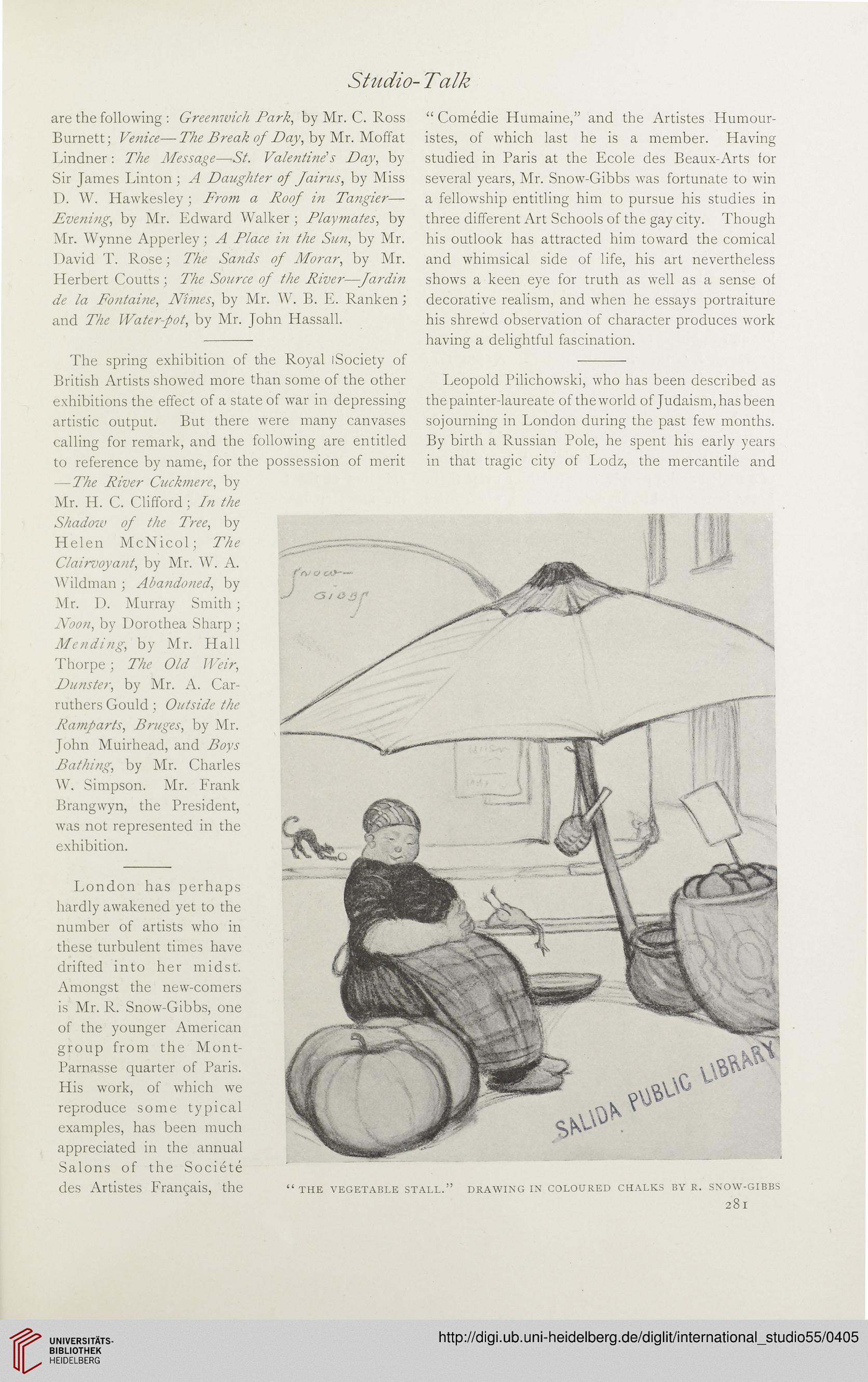Studio-Talk
Leopold Pilichowski, who has been described as
the painter-laureate of the world of Judaism, has been
sojourning in London during the past few months.
By birth a Russian Pole, he spent his early years
in that tragic city of Lodz, the mercantile and
are the following : Greenwich Park, by Mr. C. Ross
Burnett; Venice—The Break of Day, by Mr. Moffat
Lindner : The Message—St. Valentine's Day, by
Sir James Linton; A Daughter of Jairus, by Miss
D. W. Hawkesley ; From a Roof in Tangier—
Evening, by Mr. Edward Walker ; Playmates, by
Mr. Wynne Apperley; A Place in the Sun, by Mr.
David T. Rose; The Sands of Morar, by Mr.
Herbert Coutts; The Source of the River—-Jardin
de la Fontaine, Nimes, by Mr. W. B. E. Ranken;
and The Water-pot, by Mr. John Hassall.
“ Comedie Humaine,” and the Artistes Humour-
istes, of which last he is a member. Having
studied in Paris at the Ecole des Beaux-Arts for
several years, Mr. Snow-Gibbs was fortunate to win
a fellowship entitling him to pursue his studies in
three different Art Schools of the gay city. Though
his outlook has attracted him toward the comical
and whimsical side of life, his art nevertheless
shows a keen eye for truth as well as a sense of
decorative realism, and when he essays portraiture
his shrewd observation of character produces work
having a delightful fascination.
The spring exhibition of the Royal lSociety of
British Artists showed more than some of the other
exhibitions the effect of a state of war in depressing
artistic output. But there were many canvases
calling for remark, and the following are entitled
to reference by name, for the possession of merit
■—The River Cuckmere, by
Mr. H. C. Clifford; In the
Shadow of the Tree, by
Helen McNicol; The
Clairvoyant, by Mr. W. A.
Wildman ; Abandoned, by
Mr. D. Murray Smith;
Noon, by Dorothea Sharp ;
Mending, by Mr. Hall
Thorpe; The Old Weir,
Duns ter, by Mr. A. Car¬
ruthers Gould; Outside the
Ramparts, Bruges, by Mr.
John Muirhead, and Boys
Bathing, by Mr. Charles
W. Simpson. Mr. Frank
Brangwyn, the President,
was not represented in the
exhibition.
London has perhaps
hardly awakened yet to the
number of artists who in
these turbulent times have
drifted into her midst.
Amongst the new-comers
is Mr. R. Snow-Gibbs, one
of the younger American
group from the Mont-
Parnasse quarter of Paris.
His work, of which we
reproduce some typical
examples, has been much
appreciated in the annual
Salons of the Societe
des Artistes Frangais, the
“the vegetable stall.” drawing in coloured chalks by r. snow-gibbs
281
Leopold Pilichowski, who has been described as
the painter-laureate of the world of Judaism, has been
sojourning in London during the past few months.
By birth a Russian Pole, he spent his early years
in that tragic city of Lodz, the mercantile and
are the following : Greenwich Park, by Mr. C. Ross
Burnett; Venice—The Break of Day, by Mr. Moffat
Lindner : The Message—St. Valentine's Day, by
Sir James Linton; A Daughter of Jairus, by Miss
D. W. Hawkesley ; From a Roof in Tangier—
Evening, by Mr. Edward Walker ; Playmates, by
Mr. Wynne Apperley; A Place in the Sun, by Mr.
David T. Rose; The Sands of Morar, by Mr.
Herbert Coutts; The Source of the River—-Jardin
de la Fontaine, Nimes, by Mr. W. B. E. Ranken;
and The Water-pot, by Mr. John Hassall.
“ Comedie Humaine,” and the Artistes Humour-
istes, of which last he is a member. Having
studied in Paris at the Ecole des Beaux-Arts for
several years, Mr. Snow-Gibbs was fortunate to win
a fellowship entitling him to pursue his studies in
three different Art Schools of the gay city. Though
his outlook has attracted him toward the comical
and whimsical side of life, his art nevertheless
shows a keen eye for truth as well as a sense of
decorative realism, and when he essays portraiture
his shrewd observation of character produces work
having a delightful fascination.
The spring exhibition of the Royal lSociety of
British Artists showed more than some of the other
exhibitions the effect of a state of war in depressing
artistic output. But there were many canvases
calling for remark, and the following are entitled
to reference by name, for the possession of merit
■—The River Cuckmere, by
Mr. H. C. Clifford; In the
Shadow of the Tree, by
Helen McNicol; The
Clairvoyant, by Mr. W. A.
Wildman ; Abandoned, by
Mr. D. Murray Smith;
Noon, by Dorothea Sharp ;
Mending, by Mr. Hall
Thorpe; The Old Weir,
Duns ter, by Mr. A. Car¬
ruthers Gould; Outside the
Ramparts, Bruges, by Mr.
John Muirhead, and Boys
Bathing, by Mr. Charles
W. Simpson. Mr. Frank
Brangwyn, the President,
was not represented in the
exhibition.
London has perhaps
hardly awakened yet to the
number of artists who in
these turbulent times have
drifted into her midst.
Amongst the new-comers
is Mr. R. Snow-Gibbs, one
of the younger American
group from the Mont-
Parnasse quarter of Paris.
His work, of which we
reproduce some typical
examples, has been much
appreciated in the annual
Salons of the Societe
des Artistes Frangais, the
“the vegetable stall.” drawing in coloured chalks by r. snow-gibbs
281




